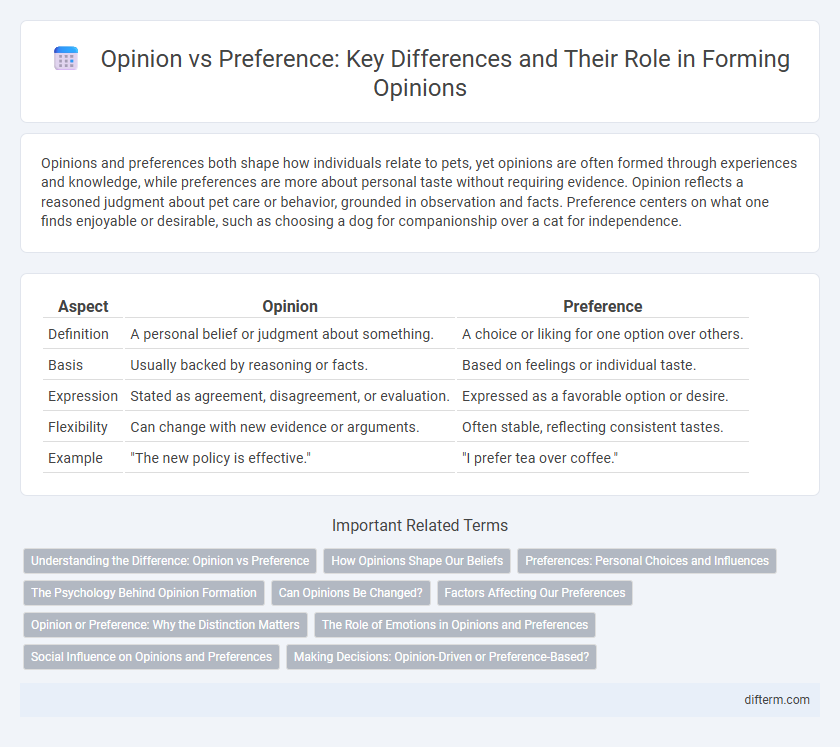Opinions and preferences both shape how individuals relate to pets, yet opinions are often formed through experiences and knowledge, while preferences are more about personal taste without requiring evidence. Opinion reflects a reasoned judgment about pet care or behavior, grounded in observation and facts. Preference centers on what one finds enjoyable or desirable, such as choosing a dog for companionship over a cat for independence.
Table of Comparison
| Aspect | Opinion | Preference |
|---|---|---|
| Definition | A personal belief or judgment about something. | A choice or liking for one option over others. |
| Basis | Usually backed by reasoning or facts. | Based on feelings or individual taste. |
| Expression | Stated as agreement, disagreement, or evaluation. | Expressed as a favorable option or desire. |
| Flexibility | Can change with new evidence or arguments. | Often stable, reflecting consistent tastes. |
| Example | "The new policy is effective." | "I prefer tea over coffee." |
Understanding the Difference: Opinion vs Preference
Opinions reflect subjective judgments or beliefs shaped by personal experiences and information, whereas preferences indicate an individual's inherent likes or dislikes without the need for justification. Understanding the difference helps clarify motivation behind choices, with opinions often open to change through evidence, while preferences tend to be more stable and emotionally driven. Distinguishing between them improves communication and decision-making by addressing both rational reasoning and personal inclination.
How Opinions Shape Our Beliefs
Opinions are cognitive expressions influenced by evidence and reasoning, playing a crucial role in shaping our beliefs through continual evaluation and reflection. Unlike preferences, which are subjective and often based on personal taste, opinions contribute to the development of knowledge frameworks by guiding decision-making and social interactions. Understanding the distinction between opinion and preference enhances critical thinking and fosters more informed, balanced perspectives.
Preferences: Personal Choices and Influences
Preferences reflect individual tastes shaped by experiences, culture, and emotions, distinguishing them from objective opinions. These personal choices vary widely and influence behavior, consumption patterns, and social interactions. Understanding preferences helps in tailoring products, services, and communication to meet specific audience needs effectively.
The Psychology Behind Opinion Formation
Opinion formation stems from cognitive processes that integrate individual beliefs, experiences, and social influences, shaping attitudes toward specific topics. Preferences, rooted in personal values and emotional responses, often reflect deeper psychological needs and affect opinion stability over time. Understanding how memory, perception, and social context interact provides critical insights into the dynamic nature of opinion development.
Can Opinions Be Changed?
Opinions represent reasoned judgments formed through evidence and reflection, whereas preferences are personal likes without basis in rational evaluation. Because opinions rely on information and logic, they can be influenced and changed by new facts, persuasive arguments, or shifts in perspective. In contrast, preferences often remain stable, as they are tied to individual tastes rather than objective reasoning.
Factors Affecting Our Preferences
Factors affecting our preferences include personal experiences, cultural background, and emotional connections, which shape how we favor certain options over others. Unlike opinions, which can be formed through rational analysis and external information, preferences are deeply rooted in individual values and subjective tastes. Understanding these influences helps clarify why people choose differently even when presented with the same facts.
Opinion or Preference: Why the Distinction Matters
Understanding the distinction between opinion and preference is crucial for clear communication and effective decision-making. An opinion represents a belief or judgment formed about something, often based on facts or reasoning, while a preference reveals a personal liking or choice influenced by individual taste or experience. Recognizing this difference helps avoid misunderstandings and fosters respectful dialogues in both personal and professional settings.
The Role of Emotions in Opinions and Preferences
Emotions play a crucial role in shaping opinions by influencing how individuals interpret information and evaluate experiences. While preferences often reflect stable, affect-driven choices based on long-term emotional connections, opinions can be more fluid, responding to immediate feelings and contextual nuances. Understanding the emotional underpinnings of both concepts reveals how subjective experiences drive decision-making and attitude formation.
Social Influence on Opinions and Preferences
Social influence significantly shapes both opinions and preferences by altering individuals' perceptions and attitudes through peer pressure, social norms, and group dynamics. While opinions are more fluid and can change with new information or social contexts, preferences tend to be more ingrained but still susceptible to social cues and cultural influences. Understanding the distinction highlights how social environments mold our judgments and choices in nuanced ways.
Making Decisions: Opinion-Driven or Preference-Based?
Opinion-driven decision-making relies on informed judgments shaped by facts and experiences, often reflecting collective viewpoints. Preference-based decisions prioritize individual tastes or desires, emphasizing subjective satisfaction over objective criteria. Balancing opinions and preferences enhances decision quality by integrating both rational analysis and personal values.
opinion vs preference Infographic

 difterm.com
difterm.com